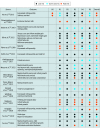Relaxation Therapy and Human Milk Feeding Outcomes: A Systematic Review and Meta-Analysis
- PMID: 38709505
- PMCID: PMC11074933
- DOI: 10.1001/jamapediatrics.2024.0814
Relaxation Therapy and Human Milk Feeding Outcomes: A Systematic Review and Meta-Analysis
Abstract
Importance: Human milk feeding is a key public health goal to optimize infant and maternal/parental health, but global lactation outcomes do not meet recommended duration and exclusivity. There are connections between lactation and mental health.
Objective: To appraise all available evidence on whether the provision of relaxation interventions to lactating individuals improves lactation and well-being.
Data sources: Embase, MEDLINE, CINAHL, Allied and Complementary Medicine Database, Web of Science, and the Cochrane Library were searched on September 30, 2023, and topic experts were consulted.
Study selection: Two independent reviewers screened for eligibility. Inclusion criteria were full-text, peer-reviewed publications with a randomized clinical trial design. Techniques that were entirely physical (eg, massage) were excluded. A total of 7% of initially identified studies met selection criteria.
Data extraction and synthesis: Two independent reviewers extracted data and assessed risk of bias with the Cochrane Risk of Bias 2 tool. Fixed-effects meta-analysis and Grading of Recommendations, Assessment, Development, and Evaluations guidelines were used to synthesize and present evidence.
Main outcomes and measures: Prespecified primary outcomes were human milk quantity, length and exclusivity of human milk feeding, milk macronutrients/cortisol, and infant growth and behavior.
Results: A total of 16 studies were included with 1871 participants (pooled mean [SD] age for 1656 participants, 29.6 [6.1] years). Interventions were music, guided relaxation, mindfulness, and breathing exercises/muscle relaxation. Provision of relaxation was not associated with a change in human milk protein (mean difference [MD], 0 g/100 mL; 95% CI, 0; 205 participants). Provision of relaxation was associated with an increase in human milk quantity (standardized mean difference [SMD], 0.73; 95% CI, 0.57-0.89; 464 participants), increased infant weight gain in breastfeeding infants (MD, z score change = 0.51; 95% CI, 0.30-0.72; 226 participants), and a slight reduction in stress and anxiety (SMD stress score, -0.49; 95% CI, -0.70 to -0.27; 355 participants; SMD anxiety score, -0.45; 95% CI, -0.67 to -0.22; 410 participants).
Conclusions and relevance: Results of this systematic review and meta-analysis suggest that provision of relaxation was associated with an increase in human milk quantity and infant weight gain and a slight reduction in stress and anxiety. Relaxation interventions can be offered to lactating parents who would like to increase well-being and improve milk supply or, where directly breastfeeding, increase infant weight gain.
Conflict of interest statement
Figures




References
-
- National Institutes of Health . Relaxation techniques: what you need to know. Accessed January 14, 2021. https://www.nccih.nih.gov/health/relaxation-techniques-for-health
-
- Belchamber C, ed. Payne’s Handbook of Relaxation Techniques: A Practical Guide for the Health Care Professional. 5th ed. Elsevier; 2010.
Publication types
MeSH terms
LinkOut - more resources
Full Text Sources
Medical
Miscellaneous

